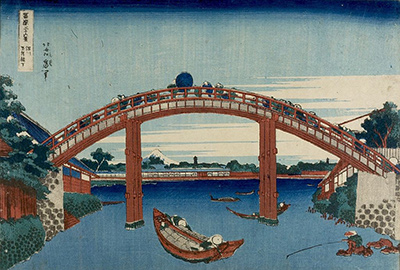Hokusai
Under Mannen Bridge at Fukagawa by Hokusai
Katsushika Hokusai’s Under Mannen Bridge at Fukagawa (Fukagawa Mannen-bashi shita), is a woodcut on paper produced for the famed—and historically significant—book Thirty-Six Views of Fuji. The print was produced around 1830 when Hokusai was well into his seventies, and is a landmark of Japanese print culture.
Hokusai considered himself a mad painter who experienced a long career (1780s-1840s), adopting numerous pseudonyms covering his different periods and styles of work. At the time Under Mannen Bridge at Fukagawa was printed, he referred to himself as Iitsu. The print features a typically designed Edo-period bridge, where a bustling crowd is depicted travelling through busy Edo (Tokyo) with their oil-paper umbrellas (wagasa).
The print is completed with various fishing and boat scenes underneath, which invoke the agrarian and mercantile setting of early nineteenth-century Fukagawa, a district of Tokyo. Beneath the bridge in the distance, Mount Fuji, the iconic symbol of Japan, can be seen with its snow-covered peak. Fuji has long been a subject of Japanese cultural significance, and Hokusai would produce numerous such prints outside of his Thirty-Six Views, which have gone on to achieve significance in their own right as reflective of Japanese art.
Hokusai’s Ukiyo-e of Mannen Bridge was produced in the later stages of the art’s flowering, when travel scenes and landscapes were produced with detailed colouring, focusing on expressive and imaginative scenes of everyday life. This move toward landscapes was historically influenced by an era known as the Tenpo Reforms; a series of policies enacted which discouraged the portrayal of lavish spectacles of wealth.
Instead, landscapes offered a timeless and unifying image of Japan’s nature, as a means of constructing a national identity, and rooting this in the surrounding philosophies of the Shinto religion. Ukiyo-e themselves were an important artistic practice throughout Japan, stretching from the late seventeenth-century and potentially earlier, which had an enduring effect on Western artists from the late-nineteenth and early-twentieth-centuries. This Ukiyo-e block was produced in a workshop by woodcarvers from a line-drawing by Hokusai, and then impressed upon fine art paper by the block.
